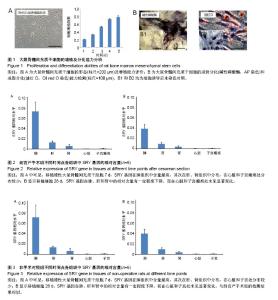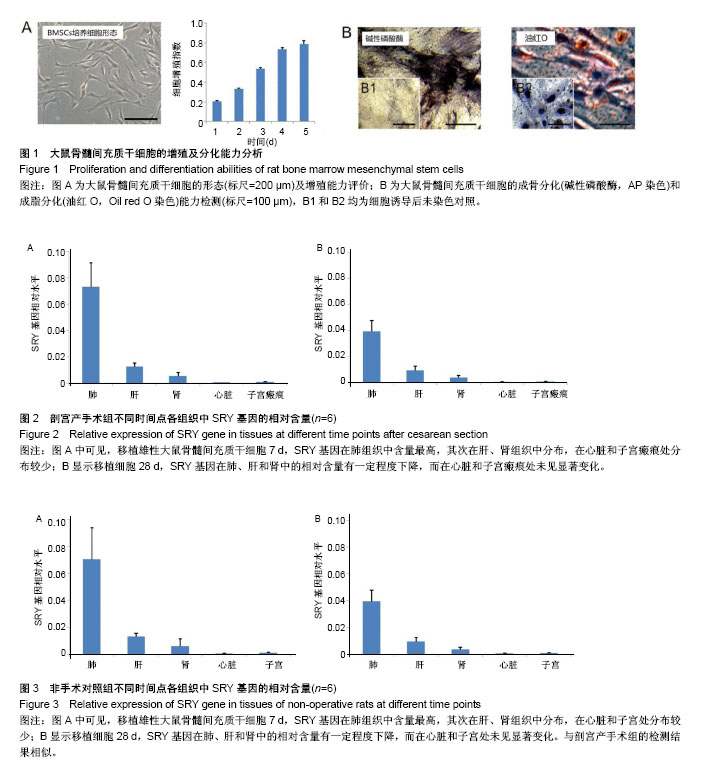Chinese Journal of Tissue Engineering Research ›› 2018, Vol. 22 ›› Issue (17): 2644-2649.doi: 10.3969/j.issn.2095-4344.0885
Previous Articles Next Articles
Cesarean section has no impact on bone marrow mesenchymal stem cell homing in pregnant rats
Sha Wen-qiong, She Rui-lian, Wang Shuo-shi, Wang Qian, Xu Man, Shi Wei, Li Lan
- Department of Obstetrics, Second Clinical Medical College of Jinan University (Shenzhen People’s Hospital), Shenzhen 518020, Guangdong Province, China
-
Revised:2018-05-07Online:2018-06-18Published:2018-06-18 -
Contact:She Rui-lian, Master, Chief physician, Department of Obstetrics, Second Clinical Medical College of Jinan University (Shenzhen People’s Hospital), Shenzhen 518020, Guangdong Province, China -
About author:Sha Wen-qiong, M.D., Associate chief physician, Department of Obstetrics, Second Clinical Medical College of Jinan University (Shenzhen People’s Hospital), Shenzhen 518020, Guangdong Province, China -
Supported by:the Science and Technology Research Plan of Shenzhen City, No. JCYJ20140416122811918
CLC Number:
Cite this article
Sha Wen-qiong, She Rui-lian, Wang Shuo-shi, Wang Qian, Xu Man, Shi Wei, Li Lan. Cesarean section has no impact on bone marrow mesenchymal stem cell homing in pregnant rats[J]. Chinese Journal of Tissue Engineering Research, 2018, 22(17): 2644-2649.
share this article

2.1 大鼠BMSCs的培养和鉴定 大鼠BMSCs呈长梭形贴壁生长,并具有较好的增殖能力。在成骨培养基和成脂培养基中体外三四周的诱导,大鼠BMSCs可向骨细胞及脂类细胞进一步分化,可分化为成脂细胞及成骨细胞(图1)。 流式细胞仪检测结果提示:BMSCs的CD29、CD44、CD73、CD90、CD105和CD166均呈阳性表达,表达效率分别为96.2%,87.9%,94.7%,89.8%,93.7%和92.9%,BMSCs的CD14、CD34和CD45均呈阴性表达,表达效率分别为0.23%,0.34%和0.54% 。 2.2 实验动物数量分析 入组的24只大鼠在处死前没有死亡,全部进入结果分析。 2.3 SRY-PCR结果 SRY基因是雄性的性别决定基因。此次研究中体外培养雄性大鼠BMSCs,经尾静脉注射入雌性大鼠体内,雌性大鼠处死后,检测组织中SRY基因含量,间接反映了组织中雄性大鼠BMSCs的存留量。 两组大鼠经尾静脉注射雄性大鼠BMSCs后,通过RT-PCR技术检测大鼠各个组织(心、肺、肝、肾、以及子宫瘢痕)中SRY基因的相对含量,从而评价BMSCs的分布水平。注射后7 d,剖宫产手术组大鼠SRY基因在肺组织中含量最高(0.073 1±0.018 4),其次在肝组织中(0.012 6± 0.002 8),在肾组织中也分布一定比例(0.005 3±0.002 7),而在心脏(0.000 6±0.000 1)和子宫瘢痕(0.001 0±0.000 3)处的SRY基因含量较少。注射后28 d,各组织中SRY基因的相对含量与7 d的检测结果略有不同,主要体现在肺(0.039 6±0.008 4)、肝(0.009 5±0.003 3)和肾(0.003 9± 0.001 6)中的相对含量均有一定程度的下降(P < 0.05),而在心脏(0.000 8±0.000 3)和子宫瘢痕(0.001 0±0.000 2)处,SRY基因的相对含量未见显著变化(P > 0.05)。见图2。 在非手术对照组(图3),孕鼠注射雄性大鼠BMSCs 7 d后,SRY基因仍然在肺组织中含量最高(0.070 5±0.023 4),其次在肝组织中含量较多(0.013 4±0.002 3),在肾组织中也分布一定比例(0.006 1±0.005 5),在心脏(0.0006± 0.0002)和子宫(0.001 1±0.000 4)处的SRY基因含量较少;注射28 d肺(0.038 4±0.020 4)、肝(0.009 1±0.002 7)和肾(0.004 0±0.001 9)中的相对含量均有一定程度的下降,而在心脏(0.000 7±0.000 3)和子宫(0.000 9±0.000 3)处,SRY的相对含量未见显著变化,总体来讲,与剖宫产手术组的检测结果相似。"

| [1] Lumbiganon P, Laopaiboon M, Gülmezoglu AM,et al.Method of delivery and pregnancy outcomes in Asia: the WHO global survey on maternal and perinatal health 2007-08.Lancet. 2010;375(9713):490-499. [2] 程蔚蔚,朱关珍.剖宫产的近期和远期并发症[J].中国实用妇科与产科杂志, 2003,19(7):442-444.[3] Roberge S, Demers S, Berghella V,et al.Impact of single- vs double-layer closure on adverse outcomes and uterine scar defect: a systematic review and metaanalysis.Am J Obstet Gynecol. 2014;211(5):453-460. [4] Fukuchi Y, Nakajima H, Sugiyama D, et al. Human placenta-derived cells have mesenchymal stem/progenitor cell potential.Stem Cells. 2004;22(5):649-658.[5] Pittenger MF, Mackay AM, Beck SC et al. Multilineage potential of adult human mesenchymal stem cells. Science. 1999;284(5411):143-147.[6] Baksh D, Yao R, Tuan RS. Comparison of proliferative and multilineage differentiation potential of human mesenchymal stem cells derived from umbilical cord and bone marrow. Stem Cells. 2007;25(6):1384-1392. [7] Campagnoli C, Roberts IA, Kumar S,et al. Identification of mesenchymal stem/progenitor cells in human first trimester fetal blood, liver, and bone marrow. Blood. 2001;98(8): 2396-2402. [8] Kinnaird T, Stabile E, Burnett MS,et al.Marrow-derived stromal cells express genes encoding a broad spectrum of arteriogenic cytokines and promote in vitro and in vivo arteriogenesis through paracrine mechanisms.Circ Res. 2004; 94(5):678-685.[9] Williams AR, Hare JM. Mesenchymal Stem Cells: Biology, Pathophysiology, Translational Findings, and Therapeutic Implications for Cardiac Disease. Circ Res. 2011;109(8): 923-940[10] Haleem AM, Singergy AA, Sabry D,et al.The Clinical Use of Human Culture-Expanded Autologous Bone Marrow Mesenchymal Stem Cells Transplanted on Platelet-Rich Fibrin Glue in the Treatment of Articular Cartilage Defects: A Pilot Study and Preliminary Results.Cartilage. 2010;1(4): 253-261.[11] Tang Y, Cai B, Yuan F, et al. Melatonin pretreatment improves the survival and function of transplanted mesenchymal stem cells after focal cerebral ischemia. Cell Transplant.2013; 23(10):1279-1291.[12] Jin Y, Bouyer J, Shumsky JS,et al. Transplantation of neural progenitor cells in chronic spinal cord injury.Neuroscience. 2016;320:69-82.[13] Mathiasen AB,Qayyum AA, Jorgensen E,et al.Bone marrow derived mesenchymal stromal cell treatment in patients with severe ischaemic heart failure: a randomized placebo- controlled trial(MSC-HF trial).Eur Heart J.2015; 36(27): 1744-1753.[14] Jayaraman P, Nathan P, Vasanthan P, et al. Stem cells conditioned medium: a new approach to skin wound healing management. Cell Biol Int.2013;37(10):1122-1128. [15] Patel DM, Shah J, Srivastava AS. Therapeutic potential of mesenchymal stem cells in regenerative medicine. Stem Cells Int.2013;2013:496218.[16] Shabbir A, Cox A, Rodriguez-Menocal L, et al. Mesenchymal Stem Cell Exosomes Induce Proliferation and Migration of Normal and Chronic Wound Fibroblasts, and Enhance Angiogenesis In Vitro. Stem Cells Dev. 2016;24(14): 1635-1647.[17] Wang Y, Chen X, Cao W, et al. Plasticity of mesenchymalstem cells in immunomodulation: pathological and therapeuticimplications. Nat Immunol. 2014;15(11): 1009-1016.[18] Hashemian SJ, Kouhnavard M, Nasli-Esfahani E.Mesenchymal stem cells: rising concerns over theirapplication in treatment of type one diabetes mellitus. J Diabetes Res. 2015;1:1-19 [19] 高杰清,谢宗燕,母义明,等.脐带间充质干细胞在2型糖尿病大鼠中的疗效及作用机制[J].中华内分泌代谢杂志, 2017,33(1): 62-67.[20] Saito Y, Shimada M, Utsunomiya T,et al.Homing effect of adipose-derived stem cells to the injured liver: the shift of stromal cell-derived factor 1 expressions.J Hepatobiliary Pancreat Sci. 2014;21(12):873-880. [21] 邓蓉蓉,谢伊旻,谢林.间充质干细胞归巢的研究与进展[J].中国组织工程研究,2016,10(19):2879-2888.[22] Ringe J, Strassburg S, Neumann K, et al. Towards insitu tissue repair: human mesenchymal stem cellsexpress chemokine receptors CXCR1, CXCR2 andCCR2, and migrate upon stimulation with CXCL8 butnot CCL2. J Cell Biochem. 2007;101(1):135-146.[23] Weeks S,Kulkarni A,Smith H,et al. The effects of chemokine, adhesion and extracellular matrix molecules on binding of mesenchymal stromal cells to poly( l -lactic acid). Cytotherapy. 2012;14(9):1080-1088.[24] 程斌,方驰华,范应方,等.骨髓间充质干细胞提取方法的改良[J].中国组织工程研究与临床康复, 2008,12(47):9293-9296.[25] Karp JM, Leng Teo GS. Mesenchymal stem cellhoming: the devil is in the details. Cell Stem Cell.2009;4(3):206-216.[26] Cheng K, Rai P, Plagov A,et al.Transplantation of bone marrow-derived MSCs improves cisplatinum-induced renal injury through paracrine mechanisms.Exp Mol Pathol. 2013; 94(3):466-473.[27] Gao J, Dennis JE, Muzic RF, et al. The dynamic in vivodistribution of bone marrow-drived mesenehymal stem cellsafter infusion. Cells Tissues Organs. 2001;169(1):12-20.[28] Liu J, Wang H, Li J.Inflammation and Inflammatory Cells in Myocardial Infarction and Reperfusion Injury: A Double-Edged Sword.Clin Med Insights Cardiol. 2016;10:79-84. [29] Halabian R, Tehrani HA, Jahanian-Najafabadi A, et al. Lipocalin-2-mediated upregulation of various antioxidants and growth factors protects bone marrow-derived mesenchymal stem cells against unfavorable microenvironments.Cell Stress Chaperones. 2013;18(6):785-800.[30] Siao CJ,Lorentz CU,Kermani P,et al.ProNGF,a cytokine induced after myocardial infarction in humans,targets pericytesto promote microvascular damage and activation.J Exp Med. 2012;209(12):2291-2305. [31] 张静,魏峰,吴忠东,等.同种异体骨髓间充质于细胞在大鼠体内心肌缺血微环境中的分化及存活[J].安徽医科大学学报, 2014, 49(3):300-303. [32] LV di Bonzo LV, Ferrero I, Cravanzola C, et al. Human mesenchymal stem cells as a two-edged sword in hepatic regenerative medicine: engraftment andhepatocyte differentiation versus profibrogenic potential. Gut. 2008; 57(2):223-231.[33] 何秀华,李东良,江军,等.移植途径对大鼠骨髓间充质干细胞归巢及肝功能恢复的影响[J].中华细胞与干细胞杂志:电子版, 2011, 1(1): 57-62. |
| [1] | Lin Qingfan, Xie Yixin, Chen Wanqing, Ye Zhenzhong, Chen Youfang. Human placenta-derived mesenchymal stem cell conditioned medium can upregulate BeWo cell viability and zonula occludens expression under hypoxia [J]. Chinese Journal of Tissue Engineering Research, 2021, 25(在线): 4970-4975. |
| [2] | Pu Rui, Chen Ziyang, Yuan Lingyan. Characteristics and effects of exosomes from different cell sources in cardioprotection [J]. Chinese Journal of Tissue Engineering Research, 2021, 25(在线): 1-. |
| [3] | Zhang Xiumei, Zhai Yunkai, Zhao Jie, Zhao Meng. Research hotspots of organoid models in recent 10 years: a search in domestic and foreign databases [J]. Chinese Journal of Tissue Engineering Research, 2021, 25(8): 1249-1255. |
| [4] | Hou Jingying, Yu Menglei, Guo Tianzhu, Long Huibao, Wu Hao. Hypoxia preconditioning promotes bone marrow mesenchymal stem cells survival and vascularization through the activation of HIF-1α/MALAT1/VEGFA pathway [J]. Chinese Journal of Tissue Engineering Research, 2021, 25(7): 985-990. |
| [5] | Shi Yangyang, Qin Yingfei, Wu Fuling, He Xiao, Zhang Xuejing. Pretreatment of placental mesenchymal stem cells to prevent bronchiolitis in mice [J]. Chinese Journal of Tissue Engineering Research, 2021, 25(7): 991-995. |
| [6] | Liang Xueqi, Guo Lijiao, Chen Hejie, Wu Jie, Sun Yaqi, Xing Zhikun, Zou Hailiang, Chen Xueling, Wu Xiangwei. Alveolar echinococcosis protoscolices inhibits the differentiation of bone marrow mesenchymal stem cells into fibroblasts [J]. Chinese Journal of Tissue Engineering Research, 2021, 25(7): 996-1001. |
| [7] | Fan Quanbao, Luo Huina, Wang Bingyun, Chen Shengfeng, Cui Lianxu, Jiang Wenkang, Zhao Mingming, Wang Jingjing, Luo Dongzhang, Chen Zhisheng, Bai Yinshan, Liu Canying, Zhang Hui. Biological characteristics of canine adipose-derived mesenchymal stem cells cultured in hypoxia [J]. Chinese Journal of Tissue Engineering Research, 2021, 25(7): 1002-1007. |
| [8] | Geng Yao, Yin Zhiliang, Li Xingping, Xiao Dongqin, Hou Weiguang. Role of hsa-miRNA-223-3p in regulating osteogenic differentiation of human bone marrow mesenchymal stem cells [J]. Chinese Journal of Tissue Engineering Research, 2021, 25(7): 1008-1013. |
| [9] | Lun Zhigang, Jin Jing, Wang Tianyan, Li Aimin. Effect of peroxiredoxin 6 on proliferation and differentiation of bone marrow mesenchymal stem cells into neural lineage in vitro [J]. Chinese Journal of Tissue Engineering Research, 2021, 25(7): 1014-1018. |
| [10] | Zhu Xuefen, Huang Cheng, Ding Jian, Dai Yongping, Liu Yuanbing, Le Lixiang, Wang Liangliang, Yang Jiandong. Mechanism of bone marrow mesenchymal stem cells differentiation into functional neurons induced by glial cell line derived neurotrophic factor [J]. Chinese Journal of Tissue Engineering Research, 2021, 25(7): 1019-1025. |
| [11] | Duan Liyun, Cao Xiaocang. Human placenta mesenchymal stem cells-derived extracellular vesicles regulate collagen deposition in intestinal mucosa of mice with colitis [J]. Chinese Journal of Tissue Engineering Research, 2021, 25(7): 1026-1031. |
| [12] | Pei Lili, Sun Guicai, Wang Di. Salvianolic acid B inhibits oxidative damage of bone marrow mesenchymal stem cells and promotes differentiation into cardiomyocytes [J]. Chinese Journal of Tissue Engineering Research, 2021, 25(7): 1032-1036. |
| [13] | Guan Qian, Luan Zuo, Ye Dou, Yang Yinxiang, Wang Zhaoyan, Wang Qian, Yao Ruiqin. Morphological changes in human oligodendrocyte progenitor cells during passage [J]. Chinese Journal of Tissue Engineering Research, 2021, 25(7): 1045-1049. |
| [14] | Wang Zhengdong, Huang Na, Chen Jingxian, Zheng Zuobing, Hu Xinyu, Li Mei, Su Xiao, Su Xuesen, Yan Nan. Inhibitory effects of sodium butyrate on microglial activation and expression of inflammatory factors induced by fluorosis [J]. Chinese Journal of Tissue Engineering Research, 2021, 25(7): 1075-1080. |
| [15] | Wang Xianyao, Guan Yalin, Liu Zhongshan. Strategies for improving the therapeutic efficacy of mesenchymal stem cells in the treatment of nonhealing wounds [J]. Chinese Journal of Tissue Engineering Research, 2021, 25(7): 1081-1087. |
| Viewed | ||||||
|
Full text |
|
|||||
|
Abstract |
|
|||||